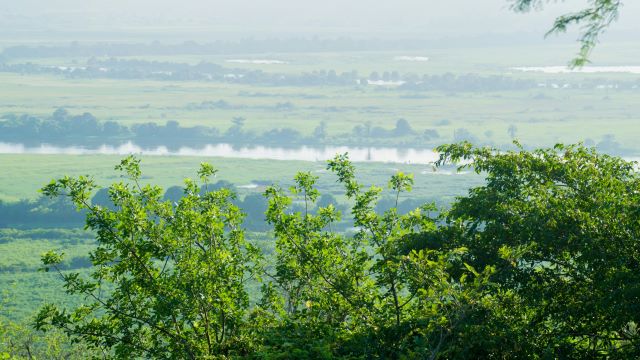By Helen Struewn
In the southwestern corner of Africa, Angola unfolds as a land of striking contrasts. From arid deserts to fertile valleys, its geography is matched by a cultural depth forged through centuries of tradition and change. Long overshadowed by better-known neighbors, this vast nation is emerging as a destination of both mystery and magnetism.
Water, Sand, and Green Horizons
In the northwestern province of Malanje, Kalandula Falls roars into a deep gorge, sending plumes of mist into the surrounding forest. At more than 100 meters in height, it ranks among the continent’s largest waterfalls—grand yet largely untroubled by crowds.
Southward, the Namib Desert crosses Angola’s border in a sweep of red dunes and stark plains. Its stillness is punctuated by abandoned mining settlements like Kolmanskop, remnants of a diamond rush that once defined the region. The light shifts constantly here, painting the sand in tones that change by the hour.
Farther north, the Bengo Province offers a verdant counterpoint. Rivers wind through farmland and low hills, culminating in Cangandala National Park. Here, the giant sable antelope—a species found nowhere else—moves quietly through the brush, its curved horns framing one of Africa’s rarest wildlife encounters.
A Cultural Tapestry
Angola’s music pulses with Semba and Kizomba, genres born on its streets and carried across Lusophone Africa. In Luanda, rhythms spill from small venues and street festivals alike, linking past and present in sound.
The capital also serves as an artistic crossroads. The 16th-century Fortaleza de São Miguel now houses cultural exhibitions and contemporary works, while the city’s sprawling markets offer traditional crafts alongside modern interpretations.
In the far north, Mbanza Kongo preserves the memory of the Kingdom of Kongo. Recognized by UNESCO, its churches, ruins, and streets trace a history of political power and cultural exchange that extended far beyond its borders.
Places of Adventure
The Okavango Delta’s northern reaches spread into Angola, where papyrus-lined channels shelter birds, hippos, and crocodiles. Canoe expeditions here pass from open water into narrow waterways, revealing wildlife at close range.
The Huila Highlands rise in the south, their cool plateaus and escarpments drawing hikers into landscapes rich with endemic flora. The views from these elevations sweep over valleys that seem untouched by time.
On the coast, Benguela offers a slower rhythm. Praia Morena and Praia da Caotinha stretch in pale arcs beside the Atlantic, their calm waters favored for swimming. The scent of grilled seafood drifts from beachside cafés, mingling with the salt air.
Practical Notes
The dry season, May to September, brings cooler temperatures ideal for wildlife viewing and outdoor travel. While roads have improved, domestic flights remain the most practical way to reach distant provinces. Health precautions, including vaccinations and malaria prophylaxis, are recommended.
For now, Angola remains a place where the known and unknown meet. Its waterfalls, deserts, and highlands frame a cultural heritage as diverse as its terrain, promising a journey that is as layered as the country itself.
Sources
- Ministry of Culture and Tourism, Angola. Tourism Development Briefing, 2023.
- UNESCO World Heritage Centre. “Historic Centre of Mbanza Kongo,” 2022.
- Silva, M. “The Giant Sable Antelope: Angola’s Endangered Icon.” African Wildlife Journal, 2021.

